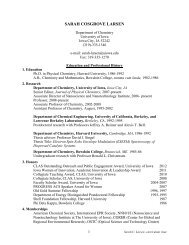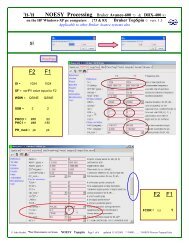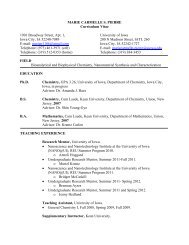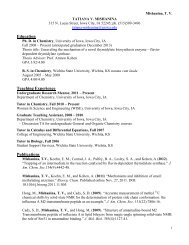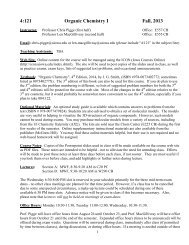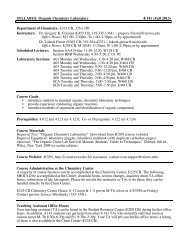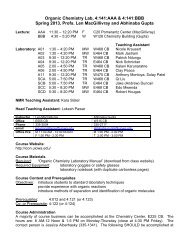J. Org. Chem. 2009, 74, 4705â4711 - American Chemical Society ...
J. Org. Chem. 2009, 74, 4705â4711 - American Chemical Society ...
J. Org. Chem. 2009, 74, 4705â4711 - American Chemical Society ...
Create successful ePaper yourself
Turn your PDF publications into a flip-book with our unique Google optimized e-Paper software.
Selective Formation of β-O-Aryl Glycosides in the Absence of theC(2)-Ester Neighboring GroupMatthew J. McKay, Benjamin D. Naab, Gregory J. Mercer, and Hien M. Nguyen*Department of <strong>Chem</strong>istry and Biochemistry, Montana State UniVersity, Bozeman, Montana 59717hmnguyen@chemistry.montana.eduReceiVed February 9, <strong>2009</strong>The development of a general and practical method for the stereoselective synthesis of β-O-aryl glycosidesthat exploits the nature of a cationic palladium(II) catalyst, instead of a C(2)-ester directing group, tocontrol the β-selectivity is described. This β-glycosylation reaction is highly diastereoselective and requires2-3 mol % of Pd(CH 3 CN) 4 (BF 4 ) 2 to activate glycosyl trichloroacetimidate donors at room temperature.The current method has been applied to D-glucose, D-galactose, and D-xylose donors with a nondirectinggroup incorporated at the C(2)-position to provide the O-aryl glycosides with good to excellent β-selectivity.In addition, its application is widespread to electron-donating, electron-withdrawing, and hindered phenols.The reaction is likely to proceed through a seven-membered ring intermediate, wherein the palladiumcatalyst coordinates to both C(1)-trichloroacetimidate nitrogen and C(2)-oxygen of the donor, blockingthe R-face. As a result, the phenol nucleophile preferentially approaches to the top face of the activateddonor, leading to formation of the β-O-aryl glycoside.(1) Bililign, T.; Griffith, B. R.; Thorson, J. S. Nat. Prod.Prep. 2005, 22, 475–516.(2) Jacobsson, M.; Malmberg, J.; Ellervik, U. Carbohydr. Res. 2006, 341,1266–1281.(3) Mahling, J.-A.; Schmidt, R. R. Synthesis 1993, 325–328.(4) (a) Ogawa, T.; Matsui, M. Carbohydr. Res. 1976, 51, C13-C18. (b)Clerici, F.; Gelmi, M. L.; Mottadelli, S. J. <strong>Chem</strong>. Soc., Perkin Trans.1 1994,985–988. (c) Mukaiyama, T.; Katsurada, M.; Iida, Y. <strong>Chem</strong>. Lett. 1992, 2105–2108. (d) Kroger, L.; Thiem, J. J. Carbohydr. <strong>Chem</strong>. 2003, 22, 9–23.IntroductionThe stereoselective synthesis of O-aryl glycosides has recentlyreceived considerable attention because these compounds areknown to exhibit antitumor, anti-HIV, and antibiotic activities. 1The synthesis of O-aryl glycosides, however, can be difficultto achieve due to the electron-withdrawing properties ofaromatic rings 2 and the facile rearrangement of the resultingO-aryl glycosides to their corresponding C-aryl glycosides. 3Additionally, steric hindrance from substituents on phenoliccompounds makes them unreactive in many glycosylationmethods. 4 Glycosyl acetates, halides, and trichloroacetimidateshave been used as donors in the formation of β-O-arylglycosides. 2 These glycosyl donors, however, only work wellwith specific phenol nucleophiles. For instance, glycosyl acetatesand trichloroacetimidates are preferred for electron-donatingphenol substrates. Glycosyl acetates usually provide the β-Oarylglycosides with lower yields than trichloroacetimidates dueto anomerization of both the glycosyl donor and the couplingproduct. 2 For instance, β-D-glucose pentaacetate undergoesanomerization to the corresponding R-D-glucose pentaacetatein the presence of 3 equiv of BF 3 · OEt 2 . 5 High temperature andlong reaction time also facilitate anomerization to give thethermodynamic R-coupling product. 6 The resulting R-O-arylglycosides are, however, often obtained in low yields due tothe formation of the undesired C-aryl glycosides. On the otherhand, glycosyl halides are strongly preferred for electronwithdrawingphenols. 2 In general, the β-O-aryl glycosides canbe formed in the glycosylation reaction by employing esterfunctionalities as the directing group at the C(2)-position ofglycosyl donors. 7 This approach, however, is not without itslimitations. In some cases, formation of ortho ester sideproducts 8 and migration of the C(2)-acyl functionality 9 are alsoobserved in the reaction.(5) Ellervik, U.; Jansson, K.; Magnusson, G. J. Carbohydr. <strong>Chem</strong>. 1998,17, 777–784.(6) Sokolov, V. M.; Zakharov, V. I.; Studentsov, E. P. Russ J. Gen. <strong>Chem</strong>.2002, 72, 806–811.(7) (a) Nukada, T.; Berces, A.; Zgierski, M. Z.; Whitfield, D. M. J. Am.<strong>Chem</strong>. Soc. 1998, 120, 13291–13295. (b) Barresi, F.; Hindsgaul, O. J. Carbohydr.<strong>Chem</strong>. 1995, 14, 1043. (c) Schmidt, R. R.; Kinzy, W. AdV. Carbohydr. <strong>Chem</strong>.Biochem. 1994, 50, 21–123. (d) Schmidt, R. R.; Michel, J. Angew. <strong>Chem</strong>., Int.Ed. 1980, 19, 731–732.10.1021/jo9002807 CCC: $40.75 © <strong>2009</strong> <strong>American</strong> <strong>Chem</strong>ical <strong>Society</strong> J. <strong>Org</strong>. <strong>Chem</strong>. <strong>2009</strong>, <strong>74</strong>, 4705–4711 4705Published on Web 06/01/<strong>2009</strong>
McKay et al.FIGURE 1. Cationic Pd(II)-catalyzed β-selective glycosylation.We report herein a new method for the stereoselectivesynthesis of β-O-aryl glycosides in the absence of the C(2)-ester directing group. This approach relies only on the natureof the cationic palladium catalyst, Pd(CH 3 CN) 4 (BF 4 ) 2 , to controlthe β-selectivity at the newly formed glycosidic bond. Thecurrent method has been applied to a number of glycosyltrichloroacetimidate donors with a nondirecting group incorporatedat the C(2)-position as well as electron-donating,electron-withdrawing, and hindered phenols to provide accessto a variety of β-O-aryl glycosides. In general, the couplingproceeds under mild conditions with 2-3 mol % ofPd(CH 3 CN) 4 (BF 4 ) 2 at room temperature. In all cases, theundesired C-aryl glycosides are not observed in the reaction.Results and DiscussionWe have recently reported a cationic palladium(II)-directedβ-selective glycosylation in the absence of the traditional C(2)-ester neighboring group effect. 10 This method relies on theability of the palladium(II) catalyst, Pd(PhCN) 2 (OTf) 2 orPd(CH 3 CN) 4 (BF 4 ) 2 , to direct β-selectivity. This reaction has beenapplied to a variety of primary, secondary, and tertiary aliphaticalcohols to provide the desired products with excellent β-selectivity.Mechanistic studies suggest that the cationic palladium(II)catalyst reversibly coordinates to both the C(1)-trichloroacetimidate nitrogen and the C(2)-ether oxygen of theglycosyl donor 1 to form a seven-membered ring intermediate2 (Figure 1). Formation of this seven-membered ring speciesblocks the R-face. As a result, the oxygen nucleophile preferentiallyapproaches to the top face of the activated donor, leadingto the formation of β-O-glycoside 3.With the success of these glycosylation processes, we seek tofurther explore the scope of this reaction with phenol nucleophilesto form β-O-aryl glycosides. Our main concern in this investigationis the ability of the cationic palladium(II) catalyst to promote therearrangement of the resulting O-aryl-glycosides to the correspondingC-aryl glycosides at high temperature. Thus, we initiallyexplored the feasibility of this concept with Pd(PhCN) 2 (OTf) 2 ,which is more reactive than Pd(CH 3 CN) 4 (BF 4 ) 2 . 10b Treatment ofboth D-glucose trichloroacetimidate donor 1 11 and 2-naphthol (4)with 2 mol % of Pd(PhCN) 2 (OTf) 2 , generated in situ from AgOTfand Pd(PhCN) 2 Cl 2 at -78 °C, provided the desired O-arylglycoside 5 as a 2:1 mixture of R- and β-isomers (Table 1, entry1). However, it took 6 h for the reaction to go to completion at-78 °C. Raising the temperature shortened the reaction time(entries 2 and 3). Since the C-aryl glycoside was not observed inTABLE 1.Stereoselective Formation of β-O-Aryl Glycoside 5 athe coupling reaction with Pd(PhCN) 2 (OTf) 2 at high temperature,we decided to explore with Pd(CH 3 CN) 4 (BF 4 ) 2 . To our delight,exposure of both 1 and 4 to 2 mol % of Pd(CH 3 CN) 4 (BF 4 ) 2 at 25°C afforded the desired O-aryl glycoside 5 in 80% yield withexcellent β-selectivity (β:R )11:1) (entry 4). The significantincrease in β-selectivity with use of Pd(CH 3 CN) 4 (BF 4 ) 2 suggeststhat these two cationic palladium catalysts operate through differentmechanisms. Since Pd(PhCN) 2 (OTf) 2 is more reactive than Pd-(CH 3 CN) 4 (BF 4 ) 2 , it promotes ionization of trichloroacetimidatedonor 1 to form an oxocarbenium intermediate; therefore, a mixtureof R- and β-isomers 5 was observed in the reaction. On the otherhand, Pd(CH 3 CN) 4 (BF 4 ) 2 promotes a seven-membered ring intermediate(Scheme 1), wherein 2-naphthol (4) preferentially approachesthe β-face of the activated donor, leading to the formationof β-O-aryl glycoside 5. Compared to other activating reagents,Pd(CH 3 CN) 4 (BF 4 ) 2 is more β-selective. Additionally, lower catalystloading and shorter reaction time were observed with use of thiscationic palladium as the activator. For example, when 4 mol %of AgOTf was employed as the activator in the coupling process,it took 12 h for the reaction to go to completion (entry 5). Thedesired O-aryl glycoside 5 was isolated in 68% yield as a mixtureof R- and β-isomers. Employing BF 3 ·OEt 2 as the activating reagentyielded 5 in 66% yield with R:β ) 3:1 (entry 6). It has also beenreported that glycosylation of 2-naphthol (4) with tetrabenzylated-D-glucopyranose in the presence of dicylohexylcarbodiimide(1 equiv.) and CuCl (2 mol %) at 80 °C provided the couplingproduct 5 as 2.4:1 mixture of β- and R-isomers. 12With the optimal conditions at hands, we set out to definethe scope of the phenol nucleophiles with this D-glucosetrichloroacetimidate donor 1 (Table 2). The cationic palladium-catalyzedβ-selective glycosylation reaction is effectivefor a variety of electron-rich and electron-withdrawingphenols, and the desired O-aryl glycoconjugates 12-15 wereisolated in good yields and β-selectivity (entries 1-4). 13Likewise, tyrosine amino acid 10 was able to couple withtrichloroacetimidate donor 1 to provide the O-aryl glycopeptide16 in excellent yield and good β-diastereoselectivity(8) (a) Seeberger, P. H.; Eckhardt, M.; Gutteridge, C. E.; Danishefsky, S. J.J. Am. <strong>Chem</strong>. Soc. 1997, 119, 10064–10072. (b) Crich, D.; Dai, Z.; Gastaldi, S.J. <strong>Org</strong>. <strong>Chem</strong>. 1999, 64, 5224–5229.(9) Yu, H.; Ensley, H. E. Tetrahedron Lett. 2003, 4, 9363–9366.(10) (a) Yang, J.; Cooper-Vanosdell, C.; Mensah, E. A.; Nguyen, H. M. J.<strong>Org</strong>. <strong>Chem</strong>. 2008, 73, 794–800. (b) Mensah, E. A.; Azzarelli, J. M.; Nguyen,H. M. J. <strong>Org</strong>. <strong>Chem</strong>. <strong>2009</strong>, <strong>74</strong>, 1650–1657.(11) (a) Zhang, J.; Yergey, A.; Kowalak, J.; Kovac, P. Tetrahedron 1998,54, 11783–11792. (b) Nakanishi, N.; Nagafuchi, Y.; Koizumi, K. J. Carbohydr.<strong>Chem</strong>. 1994, 13, 981–990. (c) Rathore, H.; Hashimoto, T.; Igarashi, K.; Nukaya,H.; Fullerton, D. Tetrahedron 1985, 41, 5427–5438. (12) Tsutsumi, H.; Ishido, Y. Carbohydr. Res. 1981, 88, 61–75.4706 J. <strong>Org</strong>. <strong>Chem</strong>. Vol. <strong>74</strong>, No. 13, <strong>2009</strong>entryPd(II)sourcesloading(mol %)T(°C)time(h)yield(%) β:R1 Pd(PhCN) 2 (OTf) 2 2 -78 6 60 2:12 Pd(PhCN) 2 (OTf) 2 2 0 3 76 1:13 Pd(PhCN) 2 (OTf) 2 2 25 1 75 1:14 Pd(CH 3 CN) 4 (BF 4 ) 2 2 25 2 80 11:15 AgOTf 4 25 12 68 1:16 BF 3 · OEt 2 4 25 6 66 3:1a All reactions were performed in CH 2 Cl 2 (0.2 M) with 2-4 mol%ofthe catalyst. b Isolated yield. c 1 H NMR ratio.
Formation of β-O-Aryl GlycosidesTABLE 2.Coupling of Phenol Nucleophiles with Glucose Donor aTABLE 3.Donor aCoupling of Phenol Nucleophiles with Galactosea All reactions were carried out in CH 2 Cl 2 with 2 mol % ofPd(CH 3 CN) 4 (BF 4 ) 2 at 25 °C. b Isolated yield. c 1 H NMR ratio.(entry 5). While other glycosylation methods slightly favorR-selectivity, 14 this palladium-catalyzed glycosylation reactionis β-selective. For example, glycosylation of 2-methylphenol(6) with tetrabenzylated D-glucose in the presenceof p-nitrobenzenesulfonyl chloride (1.1 equiv) and AgOTf(1.1 equiv) at 25 °C gave O-aryl glycoside 12 in 65% yieldwith R:β ) 3:1. 14a Under our conditions, coupling of 6 withtetrabenzylated D-glucose trichloroacetimidate 1 provided 12in 75% yield with R:β ) 1:11 (Table 2, entry 1). It has beenreported that coupling of 1-naphthol nucleophile (8) withdimethylphosphinothioate donor using AgClO 4 (1 equiv) asthe activating reagent provided 14 in 65% yield as a 3:1mixture of R- and β-isomers. 14b On the other hand, ourmethod provided 14 in 87% yield with 7:1 β-selectivity(entry 3).Our next step was to determine whether the electronwithdrawingprotecting groups on the D-glucose donor wouldaffect the β-selectivity. Accordingly, D-glucose donor 11 withthe benzoyl group incorporated at the C(4)- and C(6)-positionswas examined with phenol nucleophiles 4 and 6 (Table 2, entries6 and 7). The desired O-aryl glucosides 17 and 18 were obtainedin good yields and diasteroselectivity. These results suggest thatthe nature of the protecting group on the D-glucose donors hasa All reactions were carried out in CH 2 Cl 2 with 2 mol % ofPd(CH 3 CN) 4 (BF 4 ) 2 at 25 °C. b Isolated yield. c 1 H NMR ratio.little effect on the outcome of the stereoselectivity at the newlyformed glycosidic bond.Similarly, tetrabenzyl D-galactose trichloroacetimidate substratewas found to be a viable donor (Table 3). It was able tocouple to a variety of phenol nucleophiles to provide the desiredO-aryl galactosides 19-23 in good yields and β-selectivity(entries 1-5). Notably, the efficiency of this palladium methodologyis demonstrated by its ability to direct the relativelyhindered 2-methylphenol (6) to the top face of tetrabenzyl-Dgalactosetrichloroacetimidate donor to exclusively form β-Oarylgalactoside 19 in 73% yield (entry 1). The current methodwas further explored with D-galactose donor incorporated withthe benzoyl group at the C(4)- and C(6)-positions, even thoughparticipation of the axial C(4)-ester group to an activated(13) These compounds were relatively stable on silica gel flash chromatography.Since we were not able to separate the major β-isomer from the minora-isomer for spectral analysis, the products were subjected to preparative TLC.We found, however, that these O-aryl glycosides slowly decomposed onpreparative TLC, particularly with compounds 5, 14, and 15. As a result, it isdifficult to get clean 1 H and 13 C NMR spectra for these molecules.(14) (a) Koto, S.; Morishima, N.; Araki, M.; Tsuchiya, T. Bull. <strong>Chem</strong>. Soc.Jpn. 1981, 54, 1895–1896. (b) Yamanoi, T.; Fujioka, A.; Inazu, T. Bull. <strong>Chem</strong>.Soc. Jpn. 1994, 67, 1488–1491.J. <strong>Org</strong>. <strong>Chem</strong>. Vol. <strong>74</strong>, No. 13, <strong>2009</strong> 4707
McKay et al.TABLE 4.Coupling of Phenol Nucleophiles with Xylose Donor aTABLE 5. Selective Glycosylation of Hindered PhenolNucleophiles aa All reactions were carried out in CH 2 Cl 2 with 2 mol % ofPd(CH 3 CN) 4 (BF 4 ) 2 at 25 °C. b Isolated yield. c 1 HNMR ratio.anomeric center has previously been invoked. 15 When 2-methylphenol(6) was employed as the nucleophilic acceptor (entry6), O-aryl galactoside 24 was isolated in 87% yield and goodβ-selectivity (β:R )7:1). Use of 2-naphthol gave exclusivelyβ-isomer 25 in 78% yield (entry 7).Encouraged by the results obtained with both D-glucose andD-galactose donors, we decided to expand the scope of thisreaction with tribenzyl D-xylose trichloroacetimidate 26 (Table4). Since this xylose donor lacks the C(6)-methoxyl functionality,its β-face is likely to be less sterically hindered than that ofD-glucose and D-galactose donors. Thus, the coupling productsare expected to form with higher β-selectivity than thoseobtained from D-glucose and D-galactose donors. Accordingly,D-xylose donor 26 was coupled to an array of electron-rich andelectron-poor phenolic compounds to provide the correspondingO-aryl glycosides 28-32 in good yields and almost exclusivelyas β-isomers (Table 4).The cationic palladium-catalyzed glycosylation protocol isnot limited to unhindered electron-donating and electronwithdrawingphenol nucleophiles. Table 5 sets out severalexamples of selective formation of β-O-aryl glycosides usingsterically hindered phenols 33 and 34. These phenol acceptorshave been chosen for ease of comparison of this method withthe existing glycosylation procedures in terms of yields andanomeric selectivity. 16 In these reactions, 2-3 mol % ofPd(CH 3 CN) 4 (BF 4 ) 2 is required for the reaction to go to completion.Accordingly, coupling of 2,6-dimethylphenol (33) withtetrabenzyl D-glucose trichloroacetimidate donor 1 provided thedesired O-aryl glucoside 35 in 75% yield with β:R)10:1 (Table5, entry 1). It has been reported that coupling of 2,6-(15) Zinner, H.; Thielebeule, W. <strong>Chem</strong>. Ber. 1960, 93, 2791–2803.a The glycosylations were performed with 2 mol % ofPd(CH 3 CN) 4 (BF 4 ) 2 .b The reactions were performed with 3 mol % ofPd(CH 3 CN) 4 (BF 4 ) 2 . c Isolated yield. d 1 H NMR ratio.dimethylphenol (33) with tetrabenzyl D-glucose thioglycosidedonor afforded the coupling product 35 in excellent yield (93%),albeit in low selectivity (R:β ) 2.6:1). 15b With the sulfoxidemethod, the O-aryl glucoside 35 was obtained in 70% yield asa 2:1 mixture of R- and β-isomers. 15a Similar result was obtainedwith use of tetrabenzylated D-galactose trichloroacetimidatedonor (entry 2). Interestingly, coupling of tribenzyl D-xylosedonor 26 with 2,6-dimethylphenol (33) only yielded theβ-isomer 37 (entry 3). Encouraged by these results, we exploredthe generality and applicability of this cationic palladium methodwith 2,6-dichlorophenol (34). Gratifyingly, it was found thatthis phenol acceptor was able to couple with D-glucose donor 1and D-xylose donor 26 to provide the corresponding O-arylglycosides 38 and 39 in moderate to good yield with goodβ-selectivity (entries 4 and 5).ConclusionIn summary, we have developed an efficient method for thestereoselective synthesis of β-O-aryl glycosides in the absenceof the traditional ester directing group at the C(2)-position ofD-glucose, D-galactose, and D-xylose donors. Advantages of thecationic palladium method include its operational simplicity,using a catalytic amount of commercially available cationicpalladium, Pd(CH 3 CN) 4 (BF 4 ) 2 , as the activating reagent atambient temperature, the applicability to a broader scope ofphenol nucleophiles, and the high β-selectivity without the needof using the anchimeric assistance. In all cases, the facile(16) (a) Kahne, D.; Walker, S.; Cheng, Y.; Van Engen, D. J. Am. <strong>Chem</strong>.Soc. 1989, 111, 6881–6882. (b) Crich, D.; Sun, S. J. Am. <strong>Chem</strong>. Soc. 1998, 120,435–436.4708 J. <strong>Org</strong>. <strong>Chem</strong>. Vol. <strong>74</strong>, No. 13, <strong>2009</strong>
McKay et al.2H), 3.61 (dd, J ) 9.5, 4.5 Hz, 1H), 3.59 (s, 3H). 13 C NMR (CDCl 3 ,125 MHz): δ ) 155.5, 138.5, 138.4, 130.7, 128.4, 128.3, 128.2,128.0, 127.8, 127.7, 127.6, 127.5, 127.3, 126.7, 121.9, 114.5, 101.3,82.3, 79.2, 75.5, <strong>74</strong>.5, 73.8, 73.6, 73.4, 73.1, 68.9, 16.6. IR (film,cm -1 ): ν 2920, 2856, 1494, 1454, 1238, 1102, 1069, 752, 696.HRMS (ESI): calcd for C 41 H 42 O 6 Na (M + Na) 653.2879, found653.2853.Compound 20. 1 H NMR (CDCl 3 , 500 MHz): δ ) 7.39-7.15(m, 22H), 6.92 (d, J ) 9 Hz, 2H), 4.96 (t, J ) 11.5 Hz, 2H), 4.91(d, J ) 7.5 Hz, 1H), 4.84 (d, J ) 10.5 Hz, 1H), 4.77 (d, J ) 11.5Hz, 1H), 4.<strong>74</strong> (d, J ) 12 Hz, 1H), 4.64 (d, J ) 11.5 Hz, 1H), 4.46(d, J ) 11.5 Hz, 1H), 4.39 (d, J ) 11.5 Hz, 1H), 4.09 (dd, J ) 10,8 Hz, 1H), 3.93 (d, J ) 2.5 Hz, 1H), 3.64 (dd, J ) 12.5, 6 Hz,1H), 3.62-3.55 (m, 3H). 13 C NMR (CDCl 3 , 125 MHz): δ ) 156.5,138.4, 138.3, 138.2, 137.8, 132.3, 128.5, 128.4, 128.3, 128.2, 127.9,127.71, 127.7, 127.6, 118.7, 114.8, 101.8, 82.1, 79.1, 75.5, <strong>74</strong>.5,73.9, 73.6, 73.2, 73.1, 68.9. IR (film, cm -1 ): ν 3029, 2916, 2867,1486, 1454, 1236, 1158, 1100, 1062, 1027, 1006, 823, 734, 697.HRMS (ESI): calcd for C 40 H 39 Br O 6 Na (M + Na) 717.1828, found717.1804.Compound 21. 1 H NMR (CDCl 3 , 500 MHz): δ ) 7.<strong>74</strong> (dd, J) 13.5, 8 Hz, 2H), 7.62 (d, J ) 8.5 Hz, 1H), 7.40-7.23 (m, 24H),5.11 (d, J ) 7.5 Hz, 1H), 5.02 (d, J ) 10.5 Hz, 1H), 4.98 (d, J )11.5 Hz, 1H), 4.87 (d, J ) 10.5 Hz, 1H), 4.78 (d, J ) 12 Hz, 1H),4.<strong>74</strong> (d, J ) 12 Hz, 1H), 4.65 (d, J ) 11.5 Hz, 1H), 4.45 (d, J )11.5 Hz, 1H), 4.39 (d, J ) 11.5 Hz, 1H), 4.16 (dd, J ) 10, 8 Hz,1H), 3.95 (d, J ) 2.5 Hz, 1H), 3.<strong>74</strong> (t, J ) 6 Hz, 1H), 3.68-3.61(m, 3H). 13 C NMR (CDCl 3 , 125 MHz): δ ) 129.3, 128.4, 128.3,128.2, 127.8, 127.6, 124.2, 118.5, 101.8, 82.0, 79.2, 75.5, <strong>74</strong>.5,<strong>74</strong>.0, 73.7, 73.3, 73.1, 69.1. IR (film, cm -1 ): ν 3061, 3029, 2920,2862, 1509, 1496, 1454, 1362, 1253, 1214, 1101, 1065, 1027, 736,696. HRMS (ESI): calcd for C 44 H 42 O 6 Na (M + Na) 689.2879,found 689.2852.Compound 22. 1 H NMR (CDCl 3 , 500 MHz): δ ) 8.31 (d, J )8.5 Hz, 1H), 7.79 (d, J ) 8 Hz, 1H), 7.51-7.23 (m, 24H), 7.18 (d,J ) 8.5 Hz, 1H), 5.19 (d, J ) 7.5 Hz, 1H), 5.12 (d, J ) 10.5 Hz,1H), 5.01 (d, J ) 11.5 Hz, 1H), 4.96 (d, J ) 10.5 Hz, 1H), 4.80(d, J ) 12 Hz, 1H), 4.77 (d, J ) 11.5 Hz, 1H), 4.68 (d, J ) 11.5Hz, 1H), 4.45 (d, J ) 11.5 Hz, 1H), 4.39 (d, J ) 11.5 Hz, 1H),4.31 (dd, J ) 10, 8 Hz, 1H), 3.99 (d, J ) 2.5 Hz, 1H), 3.<strong>74</strong> (t, J) 6.5 Hz, 1H), 3.70-3.61 (m, 3H). 13 C NMR (CDCl 3 , 125 MHz):δ ) 153.0, 138.5, 138.3, 137.8, 134.5, 128.4, 128.3, 128.2, 127.9,127.8, 127.7, 127.6, 127.4, 127.3, 125.9, 125.7, 125.4, 122.3, 122.1,109.2, 101.7, 82.4, 79.3, 75.7, <strong>74</strong>.6, <strong>74</strong>.0, 73.6, 73.3, 73.1, 68.9.IR (film, cm -1 ): ν 3062, 3029, 2916, 2866, 1578, 1496, 1454, 1388,1363, 1264, 1095, 1068, 1027, 736, 697. HRMS (ESI): calcd forC 44 H 42 O 6 Na (M + Na) 689.2879, found 689.2851.Compound 23. 1 H NMR (CDCl 3 , 500 MHz): δ ) 8.29 (d, J )8.5 Hz, 1H), 8.18(d, J ) 8.5 Hz, 1H), 7.57 (t, J ) 7.5 Hz, 1H),7.46 (t, J ) 8 Hz, 1H), 7.37-7.20 (m, 21H), 7.01 (d, J ) 8.5 Hz,1H), 5.12 (d, J ) 7.5 Hz, 2H), 5.06 (d, J ) 10.5 Hz, 1H), 4.99 (d,J ) 11.5 Hz, 1H), 4.94 (d, J ) 10.5 Hz, 1H), 4.76 (t, J ) 12 Hz,1H), 4.66 (d, J ) 11.5 Hz, 1H), 4.42 (d, J ) 11.5 Hz, 1H), 4.38(d, J ) 11.5 Hz, 1H), 4.28 (dd, J ) 9.5, 8 Hz, 1H), 3.96 (d, J )2.5 Hz, 1H), 3.71 (t, J ) 6 Hz, 1H), 3.66 (dd, J ) 10, 3 Hz, 1H),3.54-3.59 (m, 2H). 13 C NMR (CDCl 3 , 125 MHz): δ ) 152.1,138.4, 138.2, 138.1, 137.8, 131.1, 128.5, 128.3, 128.0, 127.8, 127.6,126.1, 125.7, 124.2, 122.6, 109.5, 101.7, 82.4, 79.1, 75.8, <strong>74</strong>.6,<strong>74</strong>.1, 73.7, 73.2, 73.1, 68.9. IR (film, cm -1 ): ν 3063, 3029, 2923,2854, 2373, 2348, 2314, 1455, 1375, 1259, 1157, 1076, 1027, 734,696. HRMS (ESI): calc. for C 44 H 41 ClO 6 Na (M + Na) 723.2489,found 723.2468.Compound 24. 1 H NMR (CDCl 3 , 500 MHz): δ ) 81.6-7.98(m, 4H), 7.62-7.55 (m, 2H), 7.50-7.42 (m, 4H), 7.30-7.21 (m,10H), 7.15-6.91 (m, 4H), 5.89 (d, J ) 5 Hz, 1H), 5.06 (d, J ) 15Hz, 1H), 4.99 (d, J ) 15 Hz, 1H), 4.85 (d, J ) 20 Hz, 2H), 4.60(d, J ) 15 Hz, 1H), 4.51 (d, J ) 15 Hz, 2H), 4.15 (t, J ) 15 Hz,1H), 4.04 (dd, J ) 15, 10 Hz, 1H), 3.81 (dd, J ) 15, 5 Hz, 1H),2.32 (s, 3H). 13 C NMR (CDCl 3 , 125 MHz): δ ) 166.2, 165.8, 155.4,133.5, 133.3, 131.0, 130.1, 129.8, 128.3, 128.1, 127.7, 126.9, 114.8,101.5, 79.4, 78.6, 75.7, 72.3, 71.4, 67.4, 62.9, 16.6. IR (film, cm -1 ):ν 3063, 3031, 2953, 2915, 2871, 1724, 1601, 1493, 1452, 1314,1271, 1108, 1069, 1026, 910, 735, 711. HRMS (ESI): calcd forC 41 H 38 O 8 Na (M + Na) 681.2459, found 681.2479.Compound 25. 1 H NMR (CDCl 3 , 500 MHz): δ ) 8.15 (d, J )10 Hz, 2H), 8.04 (d, J ) 10 Hz, 2H), 7.77-7.71 (m, 2H), 7.62-7.55(m, 2H), 7.50-7.23 (m, 19H), 5.90 (d, J ) 5 Hz, 1H), 5.21 (d, J) 10 Hz, 1H), 5.02 (d, J ) 15 Hz, 1H), 4.86 (d, J ) 15 Hz, 2H),4.62 (d, J ) 15 Hz, 1H), 4.55-4.49 (m, 2H), 4.24 (t, J ) 15 Hz,1H), 4.09 (t, J ) 15, 1H), 3.82 (dd, J ) 15, 5 Hz, 1H). 13 C NMR(CDCl 3 , 125 MHz): δ ) 166.2, 165.8, 155.4, 137.7, 134.2, 133.3,133.2, 130.1, 129.8, 129.5, 129.4, 127.6, 127.1, 126.4, 124.4, 119.1,111.2, 101.9, 79.2, 78.6, 75.7, 72.3, 71.7, 67.3, 63.2. IR (film, cm -1 ):ν 3062, 3031, 2952, 2913, 2871, 1723, 1719, 1630, 1600, 1452,1270, 1267, 1215, 1105, 1069, 1026, 910, 732, 711. HRMS (ESI):calcd for C 44 H 38 O 8 Na (M + Na) 717.2459, found 717.2492.Compound 28. 1 HNMR (CDCl 3 , 500 MHz): δ ) 7.50-7.29(m, 14H), 7.19-7.16 (m, 2H), 7.06-6.93 (m, 2H), 5.04 (d, J ) 5Hz, 1H), 5.02 (d, J ) 15 Hz, 1H), 4.91 (bs, 2H), 4.84 (d, J ) 10Hz, 1H), 4.76 (d, J ) 10 Hz, 1H), 4.65 (d, J ) 15 Hz, 1H), 3.99(dd, J ) 10, 5 Hz, 1H), 3.73 - 3.71 (m, 3H), 3.34 (t, J ) 10 Hz,1H), 2.29 (s, 6H). 13 C NMR (CDCl 3 , 125 MHz): δ ) 155.2, 138.6,138.2, 138.1, 131.0, 127.7, 127.1, 126.3, 122.4, 114.4, 104.8, 86.8,83.7, 77.2, 75.8, <strong>74</strong>.2, 73.4, 63.7, 15.7. IR (film, cm -1 ): ν ) 3063,3030, 2906, 2866, 1590, 1493, 1454, 1357, 1236, 1085, 1027, 997,909, 751, 698. HRMS (ESI): calcd for C 33 H 34 O 5 Na (M + Na)533.2304, found 533.2322.Compound 29. 1 H NMR (CDCl 3 , 500 MHz): δ ) 7.39-7.29(m, 15H), 7.16 (d, J ) 10 Hz, 1H), 7.01 (d, J ) 10 Hz, 1H), 5.03(d, J ) 10 Hz, 1H), 5.01 (d, J ) 10 Hz, 1H), 4.93 (d, J ) 15 Hz,1H), 4.91 (d, J ) 15 Hz, 1H), 4.84 (d, J ) 10 Hz, 1H), 4.78 (d, J) 10, 5 Hz, 1H), 4.67 (d, J ) 10 Hz, 1H), 4.01 (dd, J ) 10, 5 Hz,1H), 3.75-3.63 (m, 3H), 3.35 (dd, J ) 10.5, 10 Hz, 1H), 2.64 (q,J ) 10 Hz, 2H), 1.24 (t, J ) 10 Hz, 3H). 13 C NMR (CDCl 3 , 125MHz): δ) 155.2, 138.7, 138.6, 138.3, 138.1, 128.7, 128.4, 128.0,127.9, 127.7, 116.9, 102.5, 83.6, 81.6, 7.7, 75.7, 75.1, 73.4, 28.1,15.8. IR (film, cm -1 ): ν ) 3030, 2963, 2927, 2869, 1509, 1454,1231, 10<strong>74</strong>, 1027, 997, 829, 735, 697. HRMS (ESI): calcd forC 34 H 36 O 5 Na (M + Na) 547.2460, found 547.2477.Compound 30. 1 HNMR (CDCl 3 , 500 MHz): δ ) 7.49-7.28(m, 17H), 6.91 (d, J ) 10 Hz, 1H), 4.95 (d, J ) 10 Hz, 2H), 4.90(bs, 2H), 4.82 (d, J ) 10 Hz, 1H), 4.76 (d, J ) 10 Hz, 1H), 4.65(d, J ) 10 Hz, 1H), 3.99 (dd, J ) 10, 5 Hz, 1H), 3.68-3.58 (m,3H), 3.34 (t, J ) 10 Hz, 1H), 2.64 (q, J ) 10 Hz, 2H), 1.24 (t, J) 10 Hz, 3H). 13 C NMR (CDCl 3 , 125 MHz): δ ) 158.5, 138.1,138.0, 137.8, 128.5, 128.1, 127.8, 126.8, 125.8, 118.5, 102.3, 83.5,81.4, 77.3, 75.7, 75.0, 73.4, 63.6. IR (film, cm -1 ): ν ) 3088, 3063,2903, 2867, 1590, 1486, 1454, 1357, 1235, 1085, 1027, 1006, 909,823, 735, 698. HRMS (ESI): calcd for C 32 H 31 BrO 5 Na (M + Na)597.1253, found 597.1275.Compound 31. 1 HNMR (CDCl 3 , 500 MHz): δ ) 8.32 (d, J )10 Hz, 1H), 7.86 (d, J ) 10 Hz, 1H), 7.59 (d, J ) 10 Hz, 1H),7.43-7.28 (m, 19H), 7.13 (d, J ) 10 Hz, 1H), 5.29 (d, J ) 5 Hz,1H), 5.14 (d, J ) 10 Hz, 1H), 4.96 (d, J ) 15 Hz, 3H), 4.81 (d, J) 10 Hz, 1H), 4.71 (d, J ) 15 Hz, 1H), 4.08 (dd, J ) 10, 5 Hz,1H), 3.93 (t, J ) 5 Hz, 1H), 3.81-3.75 (m, 2H), 3.47-3.42 (m,1H). 13 C NMR (CDCl 3 , 125 MHz): δ ) 152.7, 138.6, 138.1, 134.6,128.4, 127.8, 126.4, 125.7, 122.5, 122.4, 109.4, 101.8, 83.6, 81.5,77.3, 76.8, 75.4, 73.4, 63.9. IR (film, cm -1 ): ν ) 3030, 2868, 1578,1496, 1454, 1396, 1264, 1238, 937, 791, 771, 737, 697. HRMS(ESI): calcd for C 36 H 34 O 5 Na (M + Na) 569.2304, found 569.2304.Compound 32. 1 HNMR (CDCl 3 , 500 MHz): δ ) 7.83 (dd, J )10, 5 Hz, 2H), 7.80 (d, J ) 10 Hz, 1H), 7.52-7.29 (m, 19H), 5.21(d, J ) 5 Hz, 1H), 5.09 (d, J ) 10 Hz, 1H), 4.99 (d, J ) 10 Hz,1H), 4.97 (d, J ) 10 Hz, 1H), 4.91 (d, J ) 10 Hz, 1H), 4.82 (d, J) 10 Hz, 1H), 4.71 (d, J ) 10 Hz, 1H), 4.10 (dd, J ) 10, 5 Hz,1H), 3.79-3.73 (m, 3H), 3.49-3.45 (m, 1H). 13 C NMR (CDCl 3 ,125 MHz): δ ) 154.9, 138.6, 138.3, 138.1, 134.3, 128.6, 127.9,4710 J. <strong>Org</strong>. <strong>Chem</strong>. Vol. <strong>74</strong>, No. 13, <strong>2009</strong>
Formation of β-O-Aryl Glycosides127.8, 127.7, 126.5, 124.5, 119.0, 111.38, 102.3, 83.6, 81.6, 77.7,76.8, 75.7, 75.2, 73.4, 64.1. IR (film, cm -1 ): ν ) 3061, 3029, 2903,2868, 1630, 1600, 1510, 1466, 1454, 1251, 1215, 10<strong>74</strong>, 1027, 998,908, 843, 811, <strong>74</strong>7, 697. HRMS (ESI): calcd for C 36 H 34 O 5 Na (M+ Na) 569.2304, found 569.2319.Compound 35. 1 H and 13 C NMR of O-aryl glycoside 27 havebeen reported. 13 1 HNMR (CDCl 3 , 500 MHz): δ ) 7.35 (d, J ) 6.7Hz, 2H), 7.29-7.24 (m, 16H), 7.17 (d, J ) 6.4 Hz, 2H), 7.01 (d,J ) 7.1 Hz, 2H), 6.97-6.94 (m, 1H), 5.12 (d, J ) 10.8 Hz, 1H),4.96 (d, J ) 11 Hz, 1H), 4.84-4.80 (m, 3H), 4.76 (d, J ) 7.3 Hz,1H), 4.58 (d, J ) 10.7 Hz, 1H), 4.50 (d, J ) 12.1 Hz, 1H), 4.44(d, J ) 12.1 Hz, 1H), 3.75-3.68 (m, 3H), 3.66-3.59 (m, 2H),3.27 (d, J ) 6.6 Hz, 1H), 2.36 (s, 6H). 13 C NMR (CDCl 3 , 125MHz): δ ) 153.2, 138.7, 138.4, 138.2, 132.0, 128.8, 128.4, 128.3,128.2, 128.0, 127.8, 127.7, 127.6, 127.5, 124.6, 104.2, 84.8, 82.9,77.8, 75.8, 75.4, 75.0, 73.5, 68.9, 17.2. IR (film, cm -1 ): ν ) 3029,2915, 2868, 1496, 1470, 1453, 1359, 1158, 1071, 1027, 734, 695.Compound 36. 1 H NMR (CDCl 3 , 500 MHz): δ ) 7.38-7.23(m, 18H), 7.15-7.14 (m, 2H), 6.99-6.92 (m, 3H), 5.19 (d, J ) 11Hz, 1H), 5.00 (d, J ) 11.5 Hz, 1H), 4.89 (d, J ) 11 Hz, 1H), 4.79(d, J ) 12 Hz, 1H), 4.75 (d, J ) 10.5 Hz, 1H), 4.<strong>74</strong> (d, J ) 8 Hz,1H), 4.64 (d, J ) 12 Hz, 1H), 4.35 (d, J ) 12 Hz, 1H), 4.32 (d, J) 11.5 Hz, 1H), 4.10 (dd, J ) 9.5, 7.5 Hz, 1H), 3.92 (d, J ) 2.5Hz, 1H), 3.63-3.58 (m, 2H), 3.49 (dd, J ) 9.5, 5.5 Hz, 1H), 3.42(t, J ) 6.5 Hz, 1H), 2.32 (s, 6H). 13 C NMR (CDCl 3 , 125 MHz): δ) 135.9, 132.1, 128.7, 128.1, 127.8, 127.7, 127.6, 127.5, 127.49,127.43, 124.4, 82.5, 80.0, 76.7, 76.5, 76.4, 75.6, <strong>74</strong>.5, 73.8, 73.5,73.4, 73.1, 68.6, 17.2. IR (film, cm -1 ): ν 3029, 2921, 2864, 1495,1454, 1361, 1263, 1195, 1097, 1059, 1027, 733, 697, 666. HRMS(ESI): calcd for C 42 H 44 O 6 Na (M + Na) 667.3035, found 667.3015.Compound 37. 1 HNMR (CDCl 3 , 500 MHz): δ ) 7.39-7.29(m, 15H), 7.03-6.96 (m, 3H), 5.11 (d, J ) 10 Hz, 1H), 4.94 (d, J) 10 Hz, 1H), 4.92 (d, J ) 10 Hz, 1H), 4.86 (d, J ) 10 Hz, 1H),4.76 (d, J ) 10 Hz, 1H), 4.<strong>74</strong> (d, J ) 10 Hz, 1H), 4.63 (d, J ) 10Hz, 1H), 3.90 (dd, J ) 10, 5 Hz, 1H), 3.71-3.63 (m, 3H), 3.08 (t,J ) 10 Hz, 1H), 2.34 (s, 6H). 13 C NMR (CDCl 3 , 125 MHz): δ )153.0, 138.7, 138.4, 138.2, 131.8, 128.8, 128.5, 128.4 128.2, 128.1,127.9, 127.8, 127.7, 127.6, 127.5, 124.6, 84.1, 82.5, 78.1, 75.7,75.4, 73.3, 64.1, 17.1. IR (film, cm -1 ): ν ) 3064, 3029, 2912, 2862,1496, 1454, 1400, 1378, 1357, 1192, 1076, 1028, 994, 771, 736,697. HRMS (ESI): calcd for C 34 H 36 O 5 Na (M + Na) 547.2460,found 547.2469.Compound 38. 1 HNMR (CDCl 3 , 500 MHz): δ ) 7.39 (d, J )6.3 Hz, 2H), 7.34-7.18 (m, 20H), 7.02 (t, J ) 8.1 Hz, 2H), 5.24(d, J ) 7.5 Hz, 1H), 5.17 (d, J ) 10.8 Hz, 1H), 4.97 (d, J ) 10.9Hz, 1H), 4.82-4.78 (m, 3H), 4.59 (d, J ) 10.8 Hz, 1H), 4.55 (d,J ) 12.2 Hz, 1H), 4.43 (d, J ) 12.2 Hz, 1H), 3.83 (t, J ) 8.4 Hz,1H), 3.75-3.65 (m, 3H), 3.37 (dt, J ) 9.3, 3 Hz, 1H). 13 C NMR(CDCl 3 , 125 MHz): δ ) 138.7, 138.5, 138.1, 128.4, 128.0, 127.7,127.5, 127.4, 125.7, 103.4, 84.5, 82.6, 77.4, 75.8, 75.1, 73.5, 68.7.IR (film, cm -1 ): ν) 3029, 2913, 2876, 1566, 1494, 1448, 1079,775, 735, 694. HRMS (ESI): calcd for C 40 H 38 Cl 2 O 6 Na (M + Na)707.1943, found 707.1939.Compound 39. 1 HNMR (CDCl 3 , 500 MHz): δ ) 7.39-7.25(m, 17H), 7.01 (t, J ) 8 Hz, 1H), 5.32 (d, J ) 7 Hz, 1H), 5.08 (d,J ) 11 Hz, 1H), 4.88 (d, J ) 11 Hz, 1H), 4.81 (d, J ) 11 Hz, 1H),4.78 (d, J ) 11 Hz, 1H), 4.67 (d, J ) 12 Hz, 1H), 4.60 (d, J ) 12Hz, 1H), 4.05 (dd, J ) 12, 4.5 Hz, 1H), 3.80 (dd, J ) 9, 8 Hz,1H), 3.76-3.68 (m, 2H), 3.29 (dd, J ) 12, 8 Hz, 1H). 13 C NMR(CDCl 3 , 125 MHz): δ ) 129.8, 129.1, 128.4, 128.3, 127.9, 127.8,127.<strong>74</strong>, 127.7, 127.6, 125.6, 104.0, 82.8, 81.5, 77.9, 75.2, <strong>74</strong>.9,72.8, 64.1. IR (film, cm -1 ): ν ) 3030, 2905, 2871, 1566, 1496,1451, 1439, 1241, 1089, 1073, 1050, 776, <strong>74</strong>1, 696. HRMS (ESI):calcd for C 32 H 30 Cl 2 O 5 Na (M + Na) 587.1368, found 587.1398.Acknowledgment. We thank Montana State University andthe National Science Foundation (CHEM-0809200) for financialsupport.Supporting Information Available: Experimental proceduresand 1 H NMR and 13 C NMR spectra of all new compounds.This material is available free of charge via the Internet athttp://pubs.acs.org.JO9002807J. <strong>Org</strong>. <strong>Chem</strong>. Vol. <strong>74</strong>, No. 13, <strong>2009</strong> 4711



